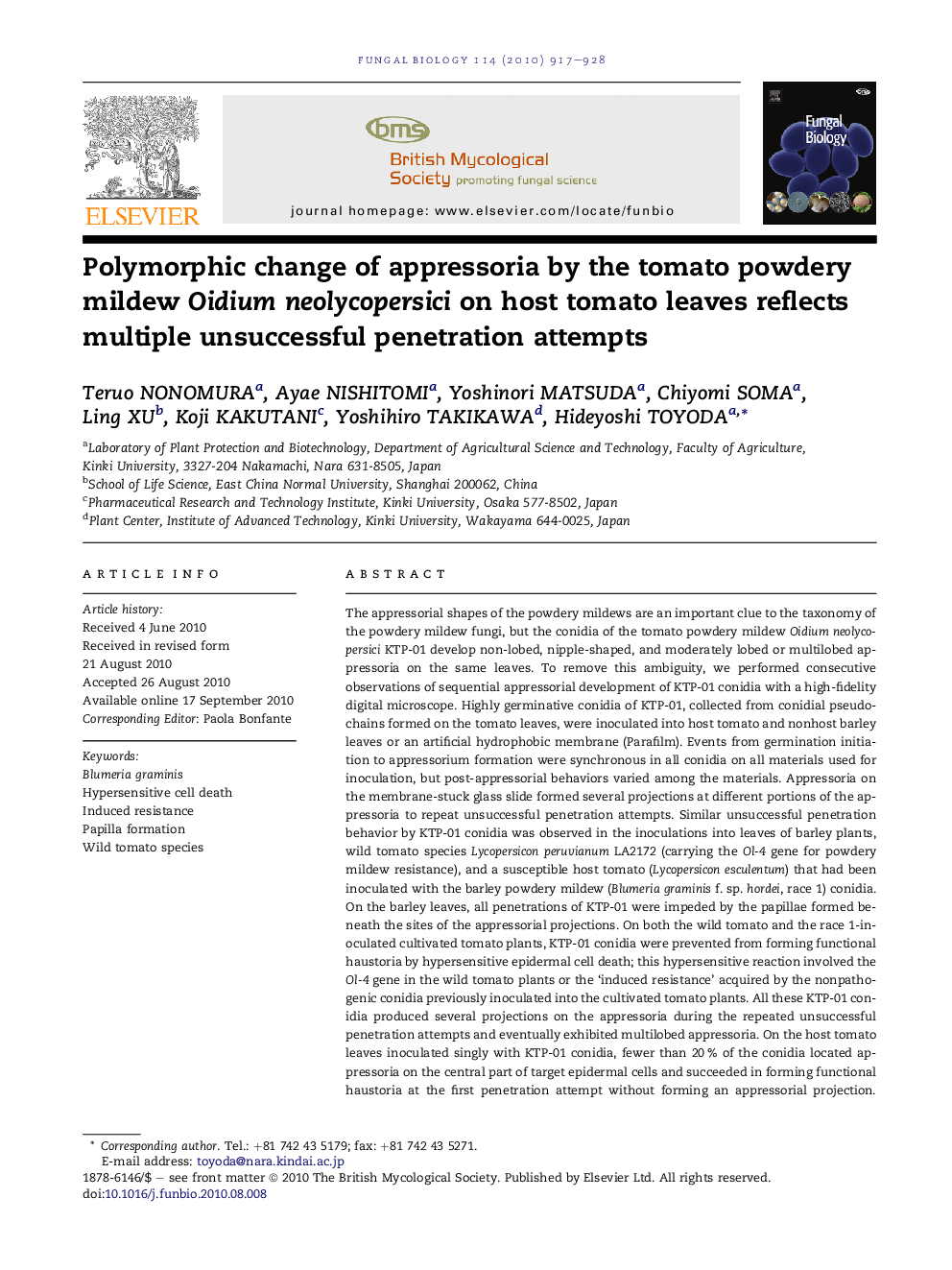| کد مقاله | کد نشریه | سال انتشار | مقاله انگلیسی | نسخه تمام متن |
|---|---|---|---|---|
| 4357261 | 1615847 | 2010 | 12 صفحه PDF | دانلود رایگان |

The appressorial shapes of the powdery mildews are an important clue to the taxonomy of the powdery mildew fungi, but the conidia of the tomato powdery mildew Oidium neolycopersici KTP-01 develop non-lobed, nipple-shaped, and moderately lobed or multilobed appressoria on the same leaves. To remove this ambiguity, we performed consecutive observations of sequential appressorial development of KTP-01 conidia with a high-fidelity digital microscope. Highly germinative conidia of KTP-01, collected from conidial pseudochains formed on the tomato leaves, were inoculated into host tomato and nonhost barley leaves or an artificial hydrophobic membrane (Parafilm). Events from germination initiation to appressorium formation were synchronous in all conidia on all materials used for inoculation, but post-appressorial behaviors varied among the materials. Appressoria on the membrane-stuck glass slide formed several projections at different portions of the appressoria to repeat unsuccessful penetration attempts. Similar unsuccessful penetration behavior by KTP-01 conidia was observed in the inoculations into leaves of barley plants, wild tomato species Lycopersicon peruvianum LA2172 (carrying the Ol-4 gene for powdery mildew resistance), and a susceptible host tomato (Lycopersicon esculentum) that had been inoculated with the barley powdery mildew (Blumeria graminis f. sp. hordei, race 1) conidia. On the barley leaves, all penetrations of KTP-01 were impeded by the papillae formed beneath the sites of the appressorial projections. On both the wild tomato and the race 1-inoculated cultivated tomato plants, KTP-01 conidia were prevented from forming functional haustoria by hypersensitive epidermal cell death; this hypersensitive reaction involved the Ol-4 gene in the wild tomato plants or the ‘induced resistance’ acquired by the nonpathogenic conidia previously inoculated into the cultivated tomato plants. All these KTP-01 conidia produced several projections on the appressoria during the repeated unsuccessful penetration attempts and eventually exhibited multilobed appressoria. On the host tomato leaves inoculated singly with KTP-01 conidia, fewer than 20 % of the conidia located appressoria on the central part of target epidermal cells and succeeded in forming functional haustoria at the first penetration attempt without forming an appressorial projection. These conidia exhibited non-lobed appressoria. The remaining conidia, however, whose appressoria were located on/near the border of the target epidermal cells, were more likely to fail to penetrate at the first penetration, and then to develop additional projections for subsequent penetrations. Most conidia succeeded in forming functional haustoria at the second to fourth penetration attempts, but a few conidia failed to produce haustoria at all attempted penetrations. Eventually, the conidia that succeeded at the second penetration possessed a single appressorial projection (exhibiting the nipple-shaped appressoria), whereas the remaining conidia exhibited moderately lobed appressoria with two to four appressorial projections and multilobed appressoria, with more projections. Thus, the present study revealed that the basic shape of appressoria of KTP-01 was the non-lobed type, and that polymorphic changes of the appressoria occurred as a result of successive production of projections during repeated unsuccessful penetration attempts.
Journal: Fungal Biology - Volume 114, Issues 11–12, November–December 2010, Pages 917–928